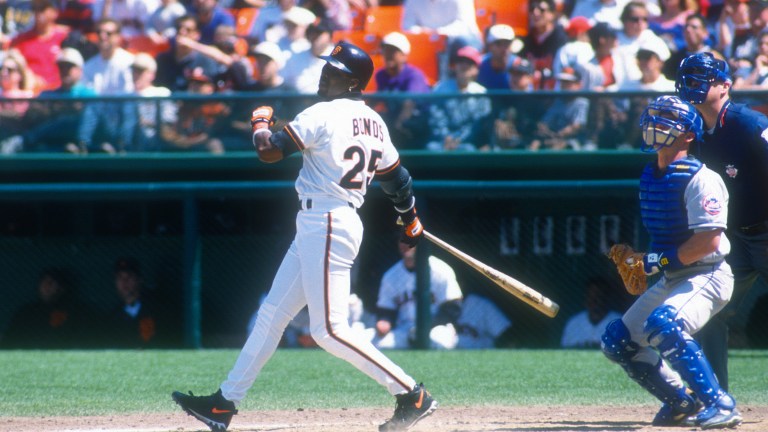The 1993 NL West: A Pennant Race We’ll Never See Again
Thirty years ago, at time where far less teams made the MLB playoffs, there was a pennant race unlike anything we will ever see again.

The race for the National League West crown in 1993 actually began in December 1992.
The Winter Meetings were in Louisville, where the San Francisco Giants came out of the gates flying. In a landmark move, they signed reigning NL MVP Barry Bonds. A day later, the Atlanta Braves countered by acquiring reigning NL Cy Young Award winner Greg Maddux.
Thirty years ago, the alignment of divisions and subsequent postseason participation was drastically different. Each league had just an East and West. Each division had seven teams. And of greatest importance to this story, only division winners advanced to the playoffs.
In what would be the final season with these parameters, the consequence of not being a first-place team came into sharper focus.
Bonds, first-time manager Dusty Baker, and new owner Peter McGowan gave the Giants a whole new identity. For a time, it didn’t seem like “San Francisco” would be part of the re-branding. But thanks to McGowan and local investors coming to the table in late 1992, a deal was in place that prevented a move to St. Petersburg, Fla.
The signing of Bonds was a watershed moment plus a nod to the past. The outfield at Candlestick Park was once occupied by Barry’s father, Bobby.
Now reunited with the organization as a hitting instructor, Bobby got to watch his son continue his dominance in the same uniform where he became a perennial 30-homer, 30-steal player. Sentiment gave way to reality, because it didn’t seem like anyone, even a team with Bonds, could challenge the Atlanta Braves — who were in the West and defied all geographic logic.
They were two-time defending National League champions, but twice a loser in the World Series. Atlanta was well-stocked in the pitching department, and this was before adding Maddux. Now it was an embarrassment of riches.
The Giants, though, were not intimidated by the supposed division champs. They were 25 games above .500 and 7.5 up in the division. Bonds was compiling another strong year, about to establish career-highs in home runs and RBIs while leading the league in both categories. San Francisco was complemented by surprisingly solid starters in Bill Swift and John Burkett.
Atlanta, meanwhile, was limited by a relatively weak offense. Ten games behind the Giants at the All-Star break, the Braves made one of the most significant in-season trades ever.
It was the spark the Braves were looking for. If that sounds like just a metaphor, it wasn’t. McGriff’s debut was delayed by a fire in the Fulton County Stadium press box. He homered that night and homered twice the following night. Atlanta won 51 of its last 68 and needed every last one of them.
McGriff’s presence lessened the pressure on David Justice, Ron Gant and Terry Pendleton — all of whom hit more to their capability down the stretch. The pitching was its usual dominant group, with Maddux posting a 2.36 ERA.
San Francisco, meanwhile, started to regress. The two teams met at Candlestick Park in late August. A Braves sweep closed the gap to 4.5 games. By mid-September, Atlanta had surged into first. The Giants gathered themselves and rallied for a tie by the final weekend of the regular season: 102 wins apiece.
The Braves had the luxury of facing the Colorado Rockies, an expansion team they hadn’t lost to all year. The Giants were at Dodger Stadium against their longtime rivals. Both won on Friday. Both won on Saturday. “The Last Great Pennant Race,” as it’s now known, came down to the bitter end. And it would be very bitter for the loser.
At this point, even 103-58 wasn’t enough to secure a playoff spot – and 104 wins wasn’t a guarantee. With the possibility of a one-game playoff in San Francisco looming, the Braves crushed the Rockies.
They then watched as the Giants sent 21-year-old Salomon Torres to the mound in an attempt to prolong their season. The plan failed miserably. Torres got a quick hook and Mike Piazza cemented his Rookie of the Year campaign with two opposite-field home runs.
It was a 12-3 dismantling. The Giants were 103 and done without a postseason game to show for it.
The two main characters at the start of this journey maintained their respective dominance. Bonds won the NL MVP for the third time in four years. Maddux won his second-straight Cy Young.
The only change was that the Braves didn’t return to the World Series. Whether or not they exhausted themselves in their climb to the top of the division, Atlanta fell in six to the Phillies in the NLCS.
But the bigger change came to the league as a whole. By 1994, Major League Baseball ensured there were six divisions, two additional playoff teams in each league, and the Wild Card race would eventually be part of the annual discussion.
For the ‘93 San Francisco Giants, it was a year too late.
